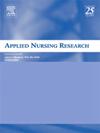Reducing documentation burden to improve nurse and midwife satisfaction: A mixed-methods study
IF 2.7
4区 医学
Q1 NURSING
引用次数: 0
Abstract
Objective
To examine midwife and nurse satisfaction pre- and post- an intervention designed to decrease documentation burden in a maternity setting.
Background
The burden imposed on nurses and midwives by documentation demands are a source of dissatisfaction, resulting in missed care, worsening job dissatisfaction.
Study design and methods
A convergent mixed-methods design (QUAN + Qual). Satisfaction was examined using a survey to collect quantitative data and focus groups to collect qualitative data. The intervention reviewed documentation for duplication, redundancy, and modification, resulting in the creation of streamlined, and user-friendly documentation. Data were collected using a validated tool developed to measure nursing and midwifery documentation burden, and via focus groups to explore satisfaction pre- and post-intervention and changes to documentation.
Results
Following integration of the data, feedback from the focus groups (n = 17) confirmed the survey results from n = 28 post-intervention respondents; participants were satisfied with many elements of the new documentation. The focus groups also highlighted areas where further refinements to the new documentation could be made. The intervention improved midwives' satisfaction with documentation with respect to ease, complexity, and relevance of the documentation. Issues with the time needed to complete documentation following the intervention remain.
Conclusion
Satisfaction with many elements of documentation was achieved, indicating that the focus on removing known sources of dissatisfaction with documentation, including duplication and unnecessary documentation, was effective in a maternity setting. Intervening to reduce duplication and redundancy, and modifying patient clinical documentation, can improve nurse and midwife satisfaction with this aspect of their job.
Reporting method
This article follows the Good Reporting of a Mixed Methods Study (GRAMMS) guidelines.1
No Patient or Public Contribution
What is already known about documentation burden
- •Clinical documentation is a medicolegal requirement.
- •There is a burden associated with clinical documentation that is a source of job dissatisfaction.
What this paper adds
- •Focusing on removing known sources of dissatisfaction with patient clinical documentation, including duplication and unnecessary documentation, is effective in decreasing nurse and midwife dissatisfaction with this part of their job.
- •How nurses and midwives perceive the continuity, consistency and quality of a maternity patient's care can be improved by removing known sources of nurse and midwife dissatisfaction with patient clinical documentation.
- •The time needed to complete documentation is a source of job dissatisfaction even after acting to improve this aspect of nurses and midwives' work, highlighting the need for continuous refinement of documentation.
减少文件负担以提高护士和助产士满意度:一项混合方法研究
目的探讨产妇干预前和干预后助产士和护士的满意度。文件要求给护士和助产士带来的负担是不满的一个来源,导致错过护理,加剧对工作的不满。研究设计和方法采用收敛混合方法设计(QUAN + Qual)。满意度研究采用问卷调查收集定量数据,焦点小组收集定性数据。干预审查了文档的重复、冗余和修改,从而创建了简化的、用户友好的文档。数据收集使用一种经过验证的工具来测量护理和助产文件负担,并通过焦点小组来探讨干预前后的满意度和文件的变化。数据整合后,焦点小组(n = 17)的反馈与干预后调查对象(n = 28)的调查结果一致;与会者对新文件的许多内容感到满意。焦点小组还强调了可以对新文件进行进一步改进的领域。干预措施提高了助产士对文件的满意度,包括文件的易用性、复杂性和相关性。干预后完成文件所需的时间问题仍然存在。结论对文件的许多要素都达到了满意度,这表明重点消除对文件的已知不满来源,包括重复和不必要的文件,在产妇环境中是有效的。干预以减少重复和冗余,修改患者临床文件,可以提高护士和助产士对这方面工作的满意度。报告方法本文遵循混合方法研究的良好报告(GRAMMS)指南。没有患者或公众的贡献什么是已知的文件负担•临床文件是一项医学法律要求。•与临床文件相关的负担是工作不满的一个来源。•专注于消除对患者临床文件的已知不满来源,包括重复和不必要的文件,有效地减少护士和助产士对这部分工作的不满。•通过消除护士和助产士对患者临床文件不满的已知来源,可以改善护士和助产士对产科患者护理的连续性、一致性和质量的看法。•完成文件所需的时间是工作不满的一个来源,即使在采取行动改善护士和助产士工作的这一方面,强调需要不断完善文件。
本文章由计算机程序翻译,如有差异,请以英文原文为准。
求助全文
约1分钟内获得全文
求助全文
来源期刊

Applied Nursing Research
医学-护理
CiteScore
4.50
自引率
0.00%
发文量
65
审稿时长
70 days
期刊介绍:
Applied Nursing Research presents original, peer-reviewed research findings clearly and directly for clinical applications in all nursing specialties. Regular features include "Ask the Experts," research briefs, clinical methods, book reviews, news and announcements, and an editorial section. Applied Nursing Research covers such areas as pain management, patient education, discharge planning, nursing diagnosis, job stress in nursing, nursing influence on length of hospital stay, and nurse/physician collaboration.
 求助内容:
求助内容: 应助结果提醒方式:
应助结果提醒方式:


